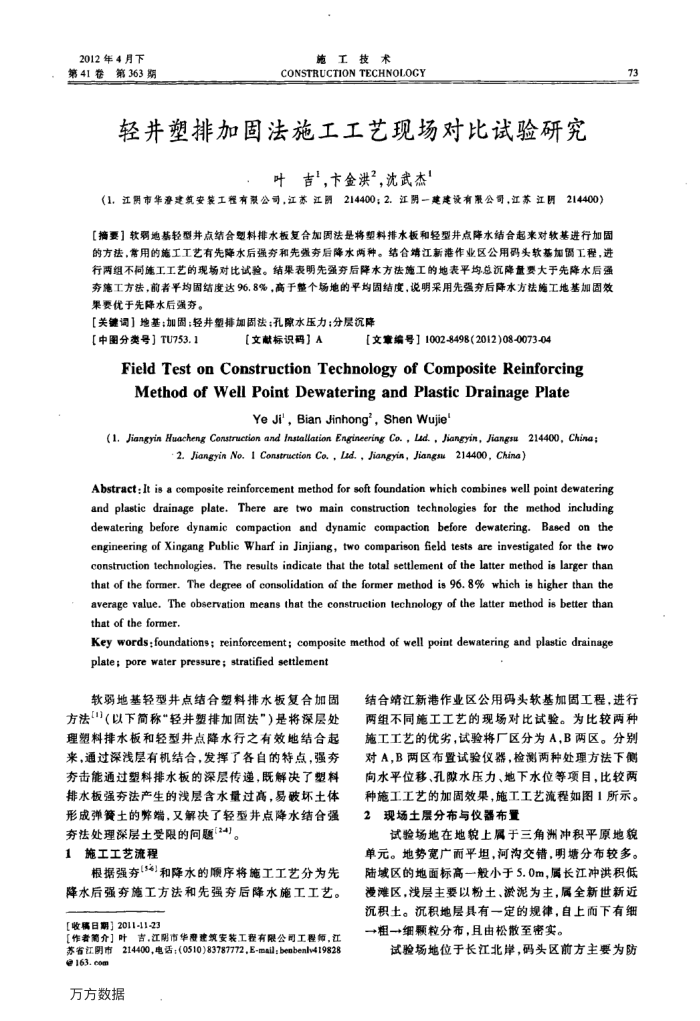您当前的位置:首页>论文资料>轻井塑排加固法施工工艺现场对比试验研究
轻井塑排加固法施工工艺现场对比试验研究
内容简介
 2012年4月下
2012年4月下第41卷
第363期
施工技术
CONSTRUCTION TECHNOLOGY
轻井塑排加固法施工工艺现场对比试验研究
叶吉",卡金洪”,沈武杰"
(1.江明市华凌建筑安装工程有限公司,江苏江阴214400;2.江明一建建设有限公司,江苏江冈214400)【摘要】软弱地基轻型并点结合塑料排水板复合加固法是将塑料排水板和轻型井点降水结合起来对软基进行加固的方法,常用的施工工艺有先降水后强夯和先强夯后降水两种。结合靖江新港作业区公用码头软基加留工程,进行两组不同施工工艺的现场对比试验。结果表明先强夯后降水方法施工的地表平均总沉降量要大于先降水后强夯施工方法,前者平均固结度达96.8%,高于整个场地的平均固结度,说明采用先强夯后降水方法施工地基加固效果要优于先降水后强夯。
【关键词】地基;加固:轻井塑排加固法:孔隙水压力;分层沉降
【中图分类号】TU753.】
【文献标识码】A
【文章编号】1002-8498(2012)08-0073-04
FieldTest on Construction Technology of Composite Reinforcing MethodofWellPointDewateringandPlasticDrainagePlate
Ye Ji',Bian Jinhong',Shen Wujie
(1. Jiangyin Huacheng Construction and Installation Engineering Co., Lid., Jiangyin, Jiangsu214400, China;
·2. Jiangyin No. 1 Construetion Co.,Lad.,Jiangyin,Jiangsu214400,China)
Abstract: It is a composite reinforcement method for soft foundation which combines well point dewatering and plastic drainage plate. There are two main construction technologies for the method including dewatering before dynamic compaction and dynamic compaction before dewatering.Based on the engineering of Xingang Public Wharf in Jinjiang, two comparison field tests are investigated for the two construction technologies. The results indicate that the total settlement of the latter method is larger than that of the former. The degree of consolidation of the former method is 96. 8% which is higher than the average value. The observation means that the construction technology of the latter method is better than that of the former.
Key words;foundations; reinforcement; composite method of well point dewatering and plastic drainage plate; pore water pressure; stratified settlement
软弱地基轻型井点结合塑料排水板复合加固方法【1](以下简称"轻井塑排加固法")是将深层处理塑料排水板和轻型井点降水行之有效地结合起来,通过深浅层有机结合,发挥了各自的特点,强夯夯击能通过塑科排水板的深层传通,既解决了塑料排水板强夯法产生的浅层含水量过高,易破坏土体形成弹簧土的弊端,又解决了轻型并点降水结合强
夯法处理深层土受限的问题[24]。 1施工工艺流程
根据强夯(3]和降水的顾序将施工工艺分为先降水后强夯施工方法和先强夯后降水施工工艺。[收隔日期]2011-11-23
【作者第介】叶吉,江附市华盈建筑安装工程有限公司工程师,江苏省江明市214400,电话:(0510)83787772,E-mail:benbenlv419828@163.com
万方数据
73
结合靖江新港作业区公用码头软基加固工程,进行两组不同施工工艺的现场对比试验。为比较两种施工工艺的优劣,试验将厂区分为A,B两区。分别对A,B两区布置试验仪器,检测两种处理方法下侧向水平位移、孔酸水压力、地下水位等项目,比较两种施工工艺的加固效果,施工工艺流程如图1所示。 2现场土层分布与仪器布置
试验场地在地貌上属于三角洲冲积平原地貌单元。地势宽广而平坦,河沟交错,明塘分布较多。陆域区的地面标高一般小于5.0m,属长江冲洪积低漫滩区,浅层主要以粉土、淤泥为主,属全新世新近沉积土。沉积地层具有一定的规律,自上而下有细一→+粗→细颗粒分布,且由松散至密实。
试验场地位于长江北岸,码头区前方主要为防